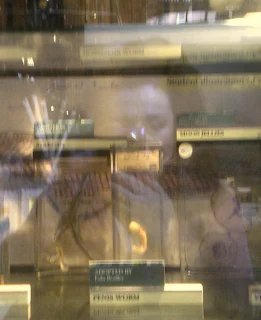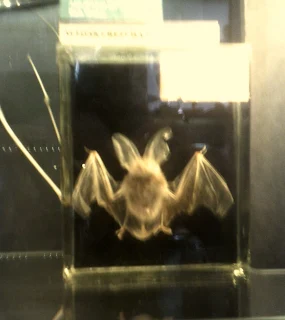The Grant Museum of Zoology and Comparative Anatomy is one of the oldest natural history collections in the UK, and is part of University College London. It is the last remaining university natural history museum in the city and is a collection of zoological specimens and dissection material.
Established by Scottish anatomist and zoologist Robert Edmund Grant (1793-1874) in 1828, for use by students, it has been open to the public since 1996.
This blog post has been outstanding for aeons! It was a boiling hot July day when we visited; the second of a trio of museums we popped into in the area. The heat was oppressive, and made me feel like my head was getting crushed in a vice, so it was a relief to venture into the cooler environs of this building.
The welcome banner outside the museum. The SuperDean thinks Robert Grant could be a long lost relative...😉
Established by Scottish anatomist and zoologist Robert Edmund Grant (1793-1874) in 1828, for use by students, it has been open to the public since 1996.
This blog post has been outstanding for aeons! It was a boiling hot July day when we visited; the second of a trio of museums we popped into in the area. The heat was oppressive, and made me feel like my head was getting crushed in a vice, so it was a relief to venture into the cooler environs of this building.
The welcome banner outside the museum. The SuperDean thinks Robert Grant could be a long lost relative...😉
It's very difficult to explain the atmosphere inside the museum. It is quiet, musty and reeks of old buildings, yet has an underlying smell that's not quite savoury. Maybe it's psychological, as you kind of expect specimens in formaldehyde (and I don't suppose that glass can contain every last drop of dead animal) to smell of something other than Chanel No. 5! Incidentally, I hate that perfume- it's like that rancid Yves St Laurent fragrance, Opium, in that it's very 'old lady'.
I apologise for the quality of the photos- I'm not sure if a flash was allowed and, even if it had been, then I couldn't have used it as it would just have reverberated off the glass.
This is the cabinet right next to the entrance, and is dedicated to worms. Along with a Tapeworm and a Velvet Worm, in the centre of the photo is a jar containing a Penis Worm (its correct name is priapulida), so named because it resembles a phallus.
You can also see a Vain Old Tart reflected in the glass.
Close-up of me and the Penis Worm. I'll leave it to you to make the jokes!😁
This is a jar of moles. I kid you not! I don't think this museum is one for those with a delicate disposition or a weak stomach...
Brain cabinet, including those of an infant tiger, a gibbon, a lemur and a porpoise. Nice!
The Quagga. This is the rarest skeleton in the world and only seven are known. The front of the animal had zebra-like brown and white stripes, but the hindquarters were plain brown and more like a horse. Genetic analysis has supported it being a subspecies of the common zebra, as opposed to a distinct species in its own right.
This is from the collection of Thomas Henry Huxley (1825-1895), who was an English biologist and anthropologist. Thylacines were also called Tasmanian tigers or marsupial wolves. They were hunted to extinction by 1936, driven by the belief that they killed sheep.
The museum contains 68,000 specimens, some of them very rare and several recently rediscovered...
The museum is really nothing more than a large, quiet room with a seated study area and a mezzanine...
The head of a wallaby...
The Dugong is a medium-sized marine mammal. Variations of the species include manatees.
A chimpanzee and a gibbon. The primate to the right looks like he's playing with some kind of makeshift didgeridoo with a bow!
This appears to be a bat, and I apologise for the less-than-best photo. Oh well, there's my excuse to return sorted...
Flying frog...
Hawksbill turtle...
Guitarfish. I don't have to explain how it gets it's name. This place was certainly full of weird and wonderful things!
Spotted ray...
Kangaroo and a Vain Old Tart...
Infant lemur...
Sponges...
Sea squirt...
Edible sea urchin and an edible (if you play your cards right😉) Vain Old Tart!😆
The Micrarium opened in 2013...
It is said that 95% of animal species are smaller than your thumb, and this is where you can come to see the tiny specimens displayed. They include beetles, a whole squid and 'legs of fleas showing muscles' - okaaaaay! I might offer up incredulous and mickey-taking humour, but this was bloody interesting!
Skeletons of mice. In jars...
This wall of jars also worked as a work of art, and was very Andy Warhol-esque...
I will return when I can, explore this museum in more depth and try and take some better photographs. Until then...
T.T.F.N.
The Miss Elaineous
XXXXXXXXXXXXXXX
XXXXX
XXX
X
X


























No comments:
Post a Comment